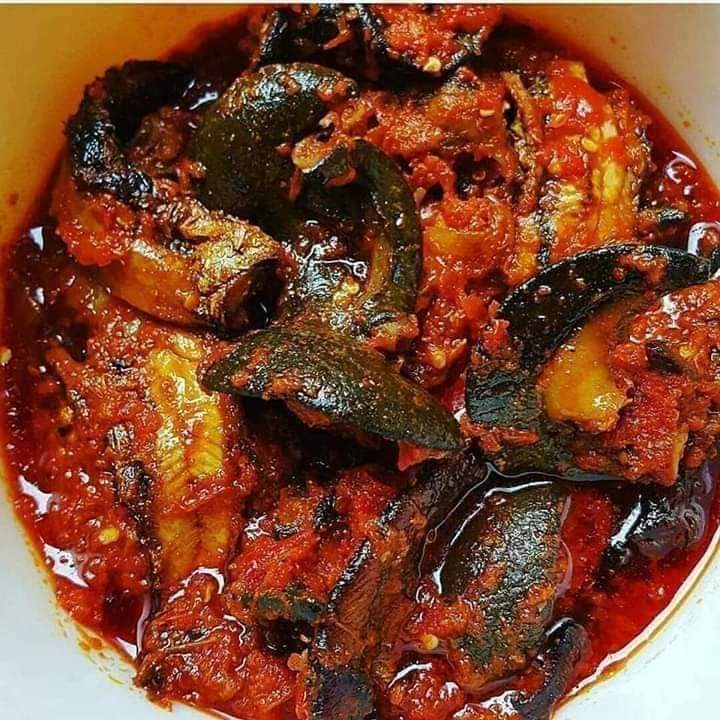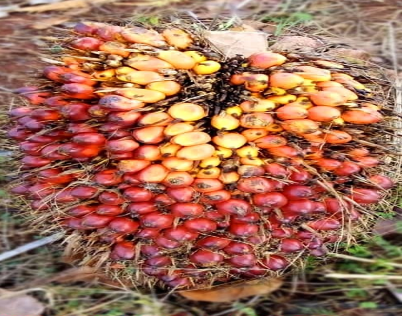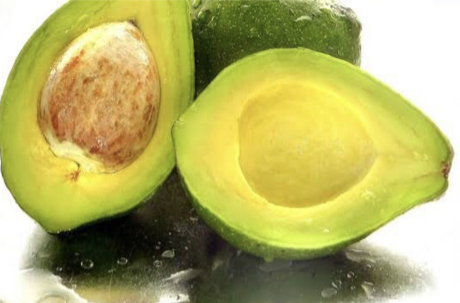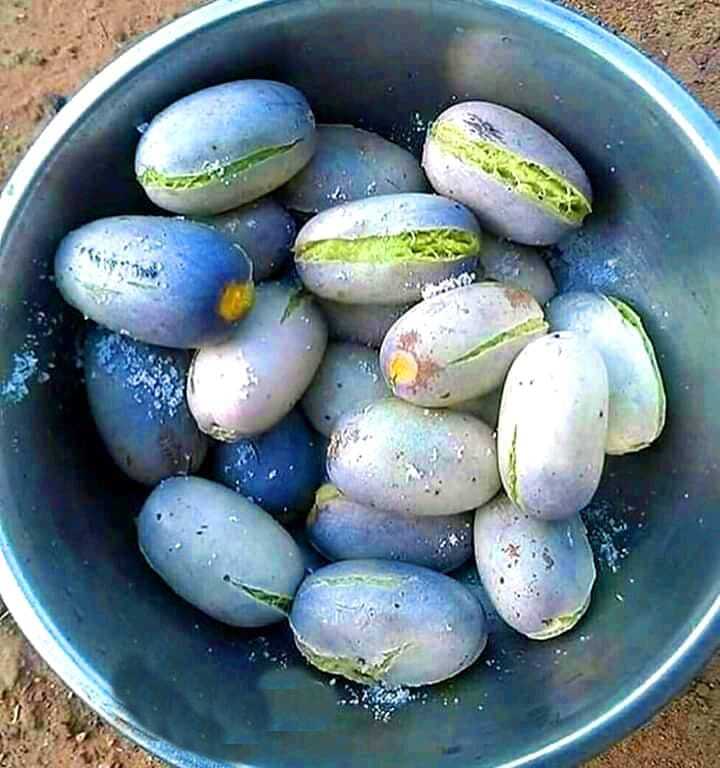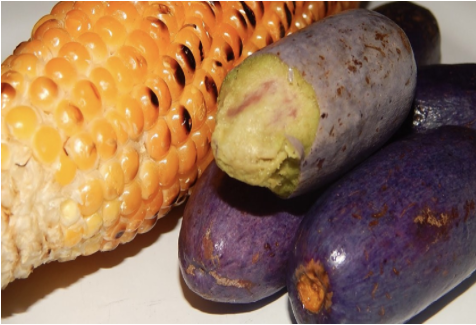colanut
COLA NUT
Cola nuts (Kola nuts) or Cola nitida (bot);
is commonly referred to as the food of the gods; in all all Africa setting. Customarily or traditionally, 'kola nut' is generally accepted as the means of communication between humans and their ancestors, at the times of performing any religious obligations.
Kola is held in high esteem above all the fruits/nuts in nature. It's a sacred fruit. Both its leaves, stems and roots are medicinal
It's forbidden for any man to rub his anus on its stem after defecation. Aside from its religious significance, kola nuts contain some plant hormones known as 'kolanin', which functions on the nervous plexus as stimulants especially for the brain, or mental alertness. It's the prime fruit offered for prayers at the start of any social/ cultural gathering, religious worships or visitation of friends. Even individual chews kola nut and uses it to bless himself and his household.
Next in command to kola nuts is the 'bitter cola', but not as important as the kola nuts.
Cola nuts (Kola nuts) or Cola nitida (bot);
is commonly referred to as the food of the gods; in all all Africa setting. Customarily or traditionally, 'kola nut' is generally accepted as the means of communication between humans and their ancestors, at the times of performing any religious obligations.
Kola is held in high esteem above all the fruits/nuts in nature. It's a sacred fruit. Both its leaves, stems and roots are medicinal
It's forbidden for any man to rub his anus on its stem after defecation. Aside from its religious significance, kola nuts contain some plant hormones known as 'kolanin', which functions on the nervous plexus as stimulants especially for the brain, or mental alertness. It's the prime fruit offered for prayers at the start of any social/ cultural gathering, religious worships or visitation of friends. Even individual chews kola nut and uses it to bless himself and his household.
Next in command to kola nuts is the 'bitter cola', but not as important as the kola nuts.
Fruits list

- Orange Alimo/Alume/Alomee
- Onion Alubasa
- Cherry Otien
- Plantain leaf Eboghede
- Palm fruits Ikpe-udin
- Pineapple Edin-ebo
- Bitterleaf Oriwo
- Pepper Asin
- Tangerine Etengari
- Mushroom Itun/Utun
- Yam Eyaen
- Rice Ize
- Melon Ogi
- Corn Oka
- Palm tree Udin
- Pounded yam Ema
- Salt Umhen
- Bean cake Eka
- Bitter kola Adu
- Kolanut Ebhie
- Plantain Oghede
- Sweet potato Eyaenebo
- Pear Olumu
- Egg Eken-okho
- Plantain cake Emienki
- Broom Owe
- Table Ukhere
- Trap Akpobe
- Cowries Ikpigho
- Bead Ivie
- Mat Ewa
- Kerosine Amorukpa
- Plate Ekpamaku
- Water Amen
- Fire Eraen
- Matches Usanu
- Bottle Ogo
- Tree Oran
- Door Ode
- House Uwa
- Farm Ugbo
- Road Uwede
- River Ede
- Stone Udo
- Rubber Alaba
- Head Uhuomhon
- Eyes Elolo
- Nose Ihue
- Ear Ehor
- Mouth Unun
- Hand Obo
- Leg Oranmen
- Palm Atata obo
- Tongue Ukpelanmhen
- Teeth Akon
- Nails Ihien
- Hair Eto
- Cheeks Agban
- Body Egbe
- Back Ikeke
Roots



These are some roots/trees found in Esan land
Soups and Ingredients
OMOEBE (BLACK SOUP)
Omoebe often referred to as black soups, are well known for their medicinal qualities. They are tasty and delicious soups that are prepared with various vegetables, prepared tree barks, roots, including choicy young (one to two day old) special tree leaves as the main ingredients; spices and local herbs, dried bush meats and dried/smoked fishes. Esan people love those soups very much, particularly, the elderlies. Many Esan individuals consider Omoebe as their favorite soups. The soups are respectively rich in nutrients for healing of various ailments and for revitalizing differing body systems, given the sets of ingredients in any specific Omoebe soup. The iron content from the pumpkin leaves (Ebe-Umenkhen) and bitter leaves (Oriwo) reduces hypertension, while the Scent leaves (Ebe-Alumonkho) are known for their anti-inflammatory properties. Also, the fact that palm fruit sauce rather than palm oil is used as the source of oil, together with the leaves makes the soup darker in colour and this is where the soup got its name (Omoebe which means Black soup). It’s best served with pounded yam, Eba or steaming starch. They do quite well with rice, yam and plantain as well.
Traditionally, a stone is used to grind the vegetables to a smoother texture. However, if you do not have a grinding stone, you can use a food processor or a blender with a bit of water. That helps to achieve the texture to some degree. Another point to note is, if you are using fresh bitter leaves, you may need to wash it multiple times to get rid of much of the bitter taste. Some people use baking soda to wash the bitter leaves or edible potash as those helps as well.
Ingredients for Esan Black Soup
Black soup ingredients may include all or a combination of some of the items of the following list, but are not limited to the following: Bitter-leaves, Scent leaves, Pumpkin leaves, etc.; beef, shaki (Tripe), kpomo (cow skin), blended crayfish, stock fish, dry/smoked fish, seasoning cubes, salt, palm nut sauce, pepper, yellow pepper and onions.
BINI OWO SOUP
Bini Owo Soup was named after a town called, Owo. This soup has become one of the oldest foods that is eaten in Esan land. We have a lot of soups in Nigeria that are prepared with vegetables like fluted pumpkin or spinach - quite unlike the Owo Soup, that is prepared with potash. It is best prepared with smoked fish, prawns or bush meat. Most people who have tasted this soup consider it as a ‘stew baptized as soup’.
The soup is mainly eaten with carbohydrates such as boiled yams, boiled plantains, sweet potatoes, boiled green bananas etc. Some also use the soup to eat boiled rice and beans. Potash is something that we rarely find in Nigerian soups. You may end up calling it stew especially when you eat the one that is served with yam or unripe plantain rather than pounded yam or eba.
OMIZAWE (GROUND-NUT SOUP)
The ground-nuts soup is very common in Esan land. It is made with ground-nuts just the way melon is used in making Egusi soup (Omo Ikpogi). The soup is a perfect, sweet and savory blend of groundnuts (izawe), tomatoes and onions, with local seasonings, leafy vegetables and either chicken, beef or fish to add extra flavor to the dish. Another part of the country where you can find a soup like Omizawe is the Northern part of the country where they serve “Miyan Taushe” and there is also an Asian sauce called “Satay Sauce” that tastes like this soup too.
OMI UKPOKA (CORN SOUP)
This is another delicious Esan soup with a unique aroma. The various spices added to the soup gives it a unique aroma. The soup is mainly made with ground dry corn (the type used for Ogi) and blended with smoked fish. The soup is mainly from the northern part of Edo state, and common to the Afemai people. The texture of the soup is much like Ofe Nsala or light Egusi Soup. Because of its high carbohydrate content, the soup is not recommended for those on a diet. It is mostly served with pounded yam, Eba, Fufu or semo-vita.
Omoebe often referred to as black soups, are well known for their medicinal qualities. They are tasty and delicious soups that are prepared with various vegetables, prepared tree barks, roots, including choicy young (one to two day old) special tree leaves as the main ingredients; spices and local herbs, dried bush meats and dried/smoked fishes. Esan people love those soups very much, particularly, the elderlies. Many Esan individuals consider Omoebe as their favorite soups. The soups are respectively rich in nutrients for healing of various ailments and for revitalizing differing body systems, given the sets of ingredients in any specific Omoebe soup. The iron content from the pumpkin leaves (Ebe-Umenkhen) and bitter leaves (Oriwo) reduces hypertension, while the Scent leaves (Ebe-Alumonkho) are known for their anti-inflammatory properties. Also, the fact that palm fruit sauce rather than palm oil is used as the source of oil, together with the leaves makes the soup darker in colour and this is where the soup got its name (Omoebe which means Black soup). It’s best served with pounded yam, Eba or steaming starch. They do quite well with rice, yam and plantain as well.
Traditionally, a stone is used to grind the vegetables to a smoother texture. However, if you do not have a grinding stone, you can use a food processor or a blender with a bit of water. That helps to achieve the texture to some degree. Another point to note is, if you are using fresh bitter leaves, you may need to wash it multiple times to get rid of much of the bitter taste. Some people use baking soda to wash the bitter leaves or edible potash as those helps as well.
Ingredients for Esan Black Soup
Black soup ingredients may include all or a combination of some of the items of the following list, but are not limited to the following: Bitter-leaves, Scent leaves, Pumpkin leaves, etc.; beef, shaki (Tripe), kpomo (cow skin), blended crayfish, stock fish, dry/smoked fish, seasoning cubes, salt, palm nut sauce, pepper, yellow pepper and onions.
BINI OWO SOUP
Bini Owo Soup was named after a town called, Owo. This soup has become one of the oldest foods that is eaten in Esan land. We have a lot of soups in Nigeria that are prepared with vegetables like fluted pumpkin or spinach - quite unlike the Owo Soup, that is prepared with potash. It is best prepared with smoked fish, prawns or bush meat. Most people who have tasted this soup consider it as a ‘stew baptized as soup’.
The soup is mainly eaten with carbohydrates such as boiled yams, boiled plantains, sweet potatoes, boiled green bananas etc. Some also use the soup to eat boiled rice and beans. Potash is something that we rarely find in Nigerian soups. You may end up calling it stew especially when you eat the one that is served with yam or unripe plantain rather than pounded yam or eba.
OMIZAWE (GROUND-NUT SOUP)
The ground-nuts soup is very common in Esan land. It is made with ground-nuts just the way melon is used in making Egusi soup (Omo Ikpogi). The soup is a perfect, sweet and savory blend of groundnuts (izawe), tomatoes and onions, with local seasonings, leafy vegetables and either chicken, beef or fish to add extra flavor to the dish. Another part of the country where you can find a soup like Omizawe is the Northern part of the country where they serve “Miyan Taushe” and there is also an Asian sauce called “Satay Sauce” that tastes like this soup too.
OMI UKPOKA (CORN SOUP)
This is another delicious Esan soup with a unique aroma. The various spices added to the soup gives it a unique aroma. The soup is mainly made with ground dry corn (the type used for Ogi) and blended with smoked fish. The soup is mainly from the northern part of Edo state, and common to the Afemai people. The texture of the soup is much like Ofe Nsala or light Egusi Soup. Because of its high carbohydrate content, the soup is not recommended for those on a diet. It is mostly served with pounded yam, Eba, Fufu or semo-vita.
SOME NOTABLE ESAN FOODS AND SNACKS.
Ema bi Omonhiele (Pounded yam and irvingia gabonensis)
“Ema bi omhonhiele” (or “Ohiele”) that is, pounded yam and Irvingia gabonensis soup (Irvingia gabonensis is the plant that is popularly called “Ogbono” or “draw soup”). This meal is the all-time favourite meal of the Esan people and is indeed, the de facto Esan national meal that tops the list of Esan local meals. Also note that, Esan people, however, eat other soups like melon soup, leaf soup a.k.a. black soup, vegetable soup, etc.)
Ori.
There are 2 types of “Ori”
It is a snack that is made from garri mixed with palm oil and molded into oblong looking shapes which is fried dry, crisp and crunchy. It is usually eaten with coconut or a syrup made from blackberries called “amoriri”.
Olene.
It is a meal that’s very popular and well loved among the Esan people. It is a type of beans that’s like soya beans (and actually a variety of it). Delicious and always a sumptuous delight, it can be eaten either alone or with a variety of other meals like roast yam, cooked yam, plantain (fried or cooked), garri, custard, cereal meals, pap, even bread, etc.
Olene is however not easy to cook, as it takes hours to get cooked. Thus, it is regularly used by Esan people to make parables and remarks that pertain to timeliness, promptness and lateness. For example, if a task that is supposed to take you a short time to complete takes you hours to complete, you will be asked whether it is Olene that you are cooking.
Oku-Oka (Ukpo-Oka)
This is corn pudding - just like beans pudding, but made with ground corn rather than ground beans.
Amumu
Amumu is made with groundnut that is ground smoothly into powder mixed with other ingredients like salt, pepper, etc., and rolled into balls of different sizes. Quite tasty and delicious and pleasant to eat, it can be eaten alone or with some meals like biscuits, bread, etc.
Ikpekele: This is, fried, crisp plantain chips, made from dry, mostly unripe plantain.
Oka bi Olumu
This is maize and native pear that is softened in hot water. It is a well-known, notable fast food/quick snack that’s a delicacy all over Nigeria in general and among the Esan people. Esan people call this combo “Oka bi Olumu”.
The maize is either cooked soft or finely roasted. Whichever one you choose is ever going to be enjoyable. Fantastic, very munchy and absolutely enjoyable, it is eaten by both the young and old - especially during its prominent new corn season. Some people also call Native pear Black pear, Bush pear or African pear.
Eyan na tonlen.
This is roast yam. Although this meal is also well eaten across Nigeria and indeed Africa, it is one of the favorite delicacies of Esan people and quite popular among them. It is sometimes eaten with any of these: palm oil that is savored with salt and ground pepper, beans, smoked fish, another renowned Esan delicacy called “Olene”.
“Ema bi omhonhiele” (or “Ohiele”) that is, pounded yam and Irvingia gabonensis soup (Irvingia gabonensis is the plant that is popularly called “Ogbono” or “draw soup”). This meal is the all-time favourite meal of the Esan people and is indeed, the de facto Esan national meal that tops the list of Esan local meals. Also note that, Esan people, however, eat other soups like melon soup, leaf soup a.k.a. black soup, vegetable soup, etc.)
Ori.
There are 2 types of “Ori”
- Ori sugar - that is the one that is savored with sugar.
- Ori Umenlen - that is the one that is savoured with salt.
It is a snack that is made from garri mixed with palm oil and molded into oblong looking shapes which is fried dry, crisp and crunchy. It is usually eaten with coconut or a syrup made from blackberries called “amoriri”.
Olene.
It is a meal that’s very popular and well loved among the Esan people. It is a type of beans that’s like soya beans (and actually a variety of it). Delicious and always a sumptuous delight, it can be eaten either alone or with a variety of other meals like roast yam, cooked yam, plantain (fried or cooked), garri, custard, cereal meals, pap, even bread, etc.
Olene is however not easy to cook, as it takes hours to get cooked. Thus, it is regularly used by Esan people to make parables and remarks that pertain to timeliness, promptness and lateness. For example, if a task that is supposed to take you a short time to complete takes you hours to complete, you will be asked whether it is Olene that you are cooking.
Oku-Oka (Ukpo-Oka)
This is corn pudding - just like beans pudding, but made with ground corn rather than ground beans.
Amumu
Amumu is made with groundnut that is ground smoothly into powder mixed with other ingredients like salt, pepper, etc., and rolled into balls of different sizes. Quite tasty and delicious and pleasant to eat, it can be eaten alone or with some meals like biscuits, bread, etc.
Ikpekele: This is, fried, crisp plantain chips, made from dry, mostly unripe plantain.
Oka bi Olumu
This is maize and native pear that is softened in hot water. It is a well-known, notable fast food/quick snack that’s a delicacy all over Nigeria in general and among the Esan people. Esan people call this combo “Oka bi Olumu”.
The maize is either cooked soft or finely roasted. Whichever one you choose is ever going to be enjoyable. Fantastic, very munchy and absolutely enjoyable, it is eaten by both the young and old - especially during its prominent new corn season. Some people also call Native pear Black pear, Bush pear or African pear.
Eyan na tonlen.
This is roast yam. Although this meal is also well eaten across Nigeria and indeed Africa, it is one of the favorite delicacies of Esan people and quite popular among them. It is sometimes eaten with any of these: palm oil that is savored with salt and ground pepper, beans, smoked fish, another renowned Esan delicacy called “Olene”.





